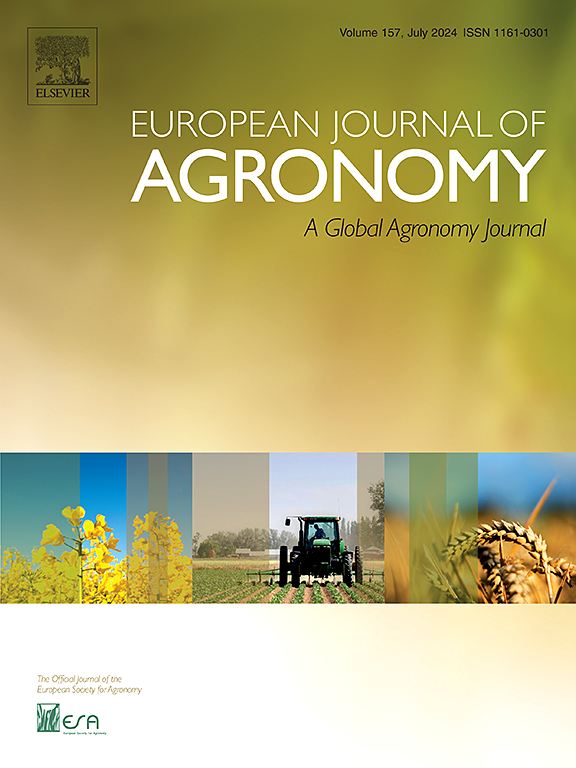在东北典型黑土区各退化类型中,土壤间伐对作物减产起主导作用
IF 4.5
1区 农林科学
Q1 AGRONOMY
引用次数: 0
摘要
黑土退化严重威胁着东北地区农业的可持续发展。尽管已有大量研究调查了土壤退化对作物产量的影响,包括土壤变薄、养分枯竭和结构退化,但导致区域作物减产的土壤退化的主要形式仍不清楚。本文综合了32项研究的488个成对观测结果,确定了东北典型黑土区土壤退化的主要类型。随后,我们研究了在优势退化类型下环境因子对作物产量的影响。我们的研究结果表明,在土壤间伐条件下,产量下降幅度最大(效应值:−27 %),其次是养分枯竭(效应值:−20 %)和土壤结构退化(效应值:−6 %)。针对土壤减薄,我们确定表层土壤深度减少5 cm为阈值,低于该阈值作物产量不会受到显著影响。土壤间伐对产量的影响呈非线性模式,表土厚度减少,产量损失严重,大豆产量降幅大于玉米。耕层深度是导致作物减产的主要因素,其次是土壤有机质(SOM)和土壤全氮(STN)。结构方程模型进一步表明,表土去除深度、试验时间和肥料类型不仅直接影响作物产量的变化,而且通过改变土壤理化性质间接影响产量。总体而言,我们的研究结果强调了土壤减薄在推动东北地区作物减产中的关键作用,并强调土壤性质是受土壤减薄影响的农业系统中作物产量恢复的关键决定因素。本文章由计算机程序翻译,如有差异,请以英文原文为准。
Soil thinning dominates crop yield reduction among various degradation types in the typical black soil region of Northeast China
The degradation of black soil poses a substantial threat to the sustainability of agriculture in Northeast China. Although numerous studies have investigated the impact of soil degradation on crop yield, including soil thinning, nutrient depletion, and structural degradation, the primary form of degradation contributing to regional crop yield reduction remains unclear. We synthesized 488 paired observations from 32 studies to identify the predominant type of soil degradation in the typical black soil region of Northeast China. Subsequently, we examined the effects of environmental factors on crop yield occurring under the dominant degradation type. Our findings indicated that the yield reduction is the greater under soil thinning (effect size: −27 %), followed by nutrient depletion (effect size: −20 %) and soil structure degradation (effect size: −6 %). Focusing on the soil thinning, we identified 5 cm reduction in topsoil depth as the threshold, below which crop yields are not significantly affected. The impacts of soil thinning on yield followed a non-linear pattern, with severe yield losses for greater reduction in topsoil thickness, and a greater reduction in soybean yield compared to maize. The depth of topsoil removal was the primary factor causing crop yield reduction, followed by soil organic matter (SOM) and total soil nitrogen (STN). The structural equation model further indicated that topsoil removal depth, experimental duration, and fertilizer types not only directly affected the changes in crop yield, but also indirectly impacted yield by altering soil physical and chemical properties. Overall, our findings highlight the critical role of soil thinning in driving crop yield reductions in Northeast China, and emphasize that soil properties are key determinants in the recovery of crop yields in agricultural systems affected by soil thinning.
求助全文
通过发布文献求助,成功后即可免费获取论文全文。
去求助
来源期刊

European Journal of Agronomy
农林科学-农艺学
CiteScore
8.30
自引率
7.70%
发文量
187
审稿时长
4.5 months
期刊介绍:
The European Journal of Agronomy, the official journal of the European Society for Agronomy, publishes original research papers reporting experimental and theoretical contributions to field-based agronomy and crop science. The journal will consider research at the field level for agricultural, horticultural and tree crops, that uses comprehensive and explanatory approaches. The EJA covers the following topics:
crop physiology
crop production and management including irrigation, fertilization and soil management
agroclimatology and modelling
plant-soil relationships
crop quality and post-harvest physiology
farming and cropping systems
agroecosystems and the environment
crop-weed interactions and management
organic farming
horticultural crops
papers from the European Society for Agronomy bi-annual meetings
In determining the suitability of submitted articles for publication, particular scrutiny is placed on the degree of novelty and significance of the research and the extent to which it adds to existing knowledge in agronomy.
 求助内容:
求助内容: 应助结果提醒方式:
应助结果提醒方式:


